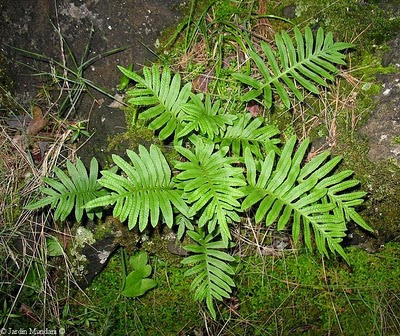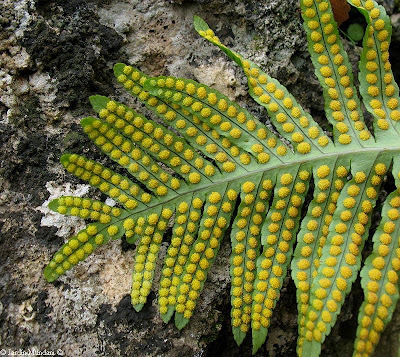This beautiful fern, so abundant in the western Mediterranean, is the descendant of a tropical Polypodium from Asia, spread over millions of years throughout Europe and North Africa, when the northern hemisphere had a tropical climate. Later, when the weather cools, some of their descendants became extinct, surviving only Polypodium cambricum, who took refuge in warm, humid microclimates in the Mediterranean region. A subsequent warming allowed to leave their shelter and settle throughout the western Mediterranean, arriving in their expansion into the British Isles. Precisely there, in Wales, which in classical Latin was called Cambria, comes the name of Polypodium cambricum. It is a fern with a diploid chromosome number of 2n = 74.

Numerous specimens of Polypodium cambricum on a wall of a terrace in the Sierra de Na Bourgeois, close to Palma de Mallorca, with a lush natural vegetation.
Young Polypodium cambricum photographed in the extraordinary Parque Natural de los Alcornocales in the province of Cadiz, growing on rich humus formed by decomposed leaves of old cork oak, Quercus suber. The fronds of Polypodium cambricum can reach a length greater than 50 cms. The lamina is greater than the petiole and has a form of ovate-oblong to ovate-triangular, sometimes clearly deltoidea, with pinnae usually attenuated at the apex and edge subentire or serrulated, the basal pair reflex in another plane, as can be seen in the largest frond of specimen of the photo.
Old Polypodium cambricum photographed at the Natural Park Sierra de Grazalema, a true paradise on earth with an extraordinary rich flora located in Andalusia. In the frond on the left tell it the characteristic basal pair of pinnae reflex upward.
Vigorous specimens with fronds over 50 inches growing on a wall in a garden patch of the Soller Valley on the Island of Mallorca. This fern also grows as an epiphyte on tree branches in humid environments. In the summer enters aestivation, its fronds are dried, leaving the rhizome pending the first autumn rains, then sprouting new fronds.


One of the features which distinguish the Polypodium cambricum of others Polypodium is the presence of a filamentous epidermal formations than trichomes, called paraphyses, which are located in the receptacle of the sorus of Polypodium cambricum, both in the Mediterranean subspecies as the Macaronesian. These filaments are much branched, with its length substantially greater than that of the sporangia. Their number in each sorus usually varies between 5 and 10 paraphyses.
Another branched paraphyses typical of Polypodium cambricum sori. Polypodium vulgare and its hybrid Polypodium interjectum paraphyses lacking. We can see by looking a sorus at a microscope, protruding above the sporangia. Its function is unknown.
On the underside of the pinnae are some mouth-shaped cells, called stomata, which open or close depending on the degree of humidity, to prevent or allow the flow of water through transpiration. Its function is similar to human skin pores. The photo shows the odd-shaped cellular structure puzzle, so that each cell fits into neighboring cells. (Double click on the photo to enlarge)
Rhizomes covered with paleae, which protect them from dehydration, sunstroke and frostbite.
Detail of a rhizome of Polypodium cambricum covered by paleae linear-lanceolate, ferruginous, 5 to 16 mm. long. The appearance at first sight recalls the wooliness of muskoxen and mammoths.
Turning to a frond sori are without indusium, distributed in two rows on the underside of each pinna along the midrib.
Double clicking on the picture to enlarge You can see details of the sori naked without covering them indusium formed by numerous yellow sporangia in different stages of maturation, photographed in February.
Detail of sori with mature sporangia, some already deployed, initiating the dispersal of spores in late winter.
Microscopic photograph of a sorus in which by transparency can be seen the spores contained in each of the sporangia. (Double click on the photo to enlarge)
Polypodium cambricum sporangium already deployed after the dispersal of spores. In the center of the image is the ring of thickened cells, whose number can vary from a minimum of 4 and a maximum of 18, but generally is around 7 cells.
And finally in this microscopic image made at 400 increases are reniform spores of a color similar to honey with the warty surface or perispore.

















No comments:
Post a Comment